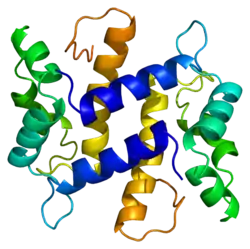Psoriasin
S100 calciumbindendes Protein A7 (S100A7), auch bekannt als Psoriasin, ist ein Protein aus der Gruppe der S-100-Proteine, das beim Menschen von dem Gen S100A7 kodiert wird.[1]
| Psoriasin | ||
|---|---|---|
 | ||
| nach PDB 1PSR | ||
| Andere Namen |
| |
| Eigenschaften des menschlichen Proteins | ||
| Masse/Länge Primärstruktur | 11,471 kDa / 101 AS[1] | |
| Bezeichner | ||
| Gen-Namen | S100A7 PSOR1 S100A7C | |
| Externe IDs | ||
| Vorkommen | ||
| Homologie-Familie | HOG000154231 | |
Funktion
S100A7 ist ein Mitglied der S100-Proteinfamilie und beinhaltet zwei calciumbindende EF-Hand-Motive. S100-Proteine sind im Cytoplasma und/oder Zellkern einer breiten Palette von Zellen lokalisiert und an der Regulation einer Reihe von zellulären Prozessen, wie dem Fortschreiten des Zellzyklus und der Zelldifferenzierung beteiligt. Die Gruppe der S100-Gene beinhaltet mindestens 13 Mitglieder, die in einem Cluster auf Chromosom 1q21 lokalisiert sind. S100A7 unterscheidet sich von den anderen S100-Proteinen mit bekannter Struktur dadurch, dass ihm die Möglichkeit zur Calciumbindung in einer EF-Hand am N-Terminus fehlt.
Das Protein fungiert zudem als ein prominentes antimikrobielles Peptid, hauptsächlich gegen Escherichia coli.[2] Es wird von Epithelzellen der Haut sezerniert und wirkt als Schlüsselprotein gegen E. coli, indem es den Aufbau von dessen Zellmembranen stört. Das ist ein Grund dafür, dass es in Ländern mit schlechten Hygienebedingungen trotz häufigem Hautkontakt mit E. coli-Stämmen aus Fäkalien normalerweise nicht zu Infektionen kommt.[3]
S100A7 ist hochgradig homolog zu S100A15 (Koebnerisin), unterscheidet sich aber in Genexpression, im Vorkommen im Gewebe und in der Funktion.[4][5][6][7]
Klinische Bedeutung
Dieses Protein ist deutlich überexprimiert in den Hautläsionen der Schuppenflechte, ist aber als Kandidat für familiäre Häufung dieser Krankheit ausgeschlossen.[2] Ebenfalls ist die Serumkonzentration von Psoriasin bei Psoriasispatienten und Patienten mit anderen entzündlichen Dermatosen erhöht.[8] Die Expression von Psoriasin wird in Hautverletzungen durch Aktivierung des EGF-Rezeptors induziert.[9]
Wechselwirkungen
Es konnte gezeigt werden, dass S100A7 mit COPS5,[10] FABP5[11][12] und RANBP9[13] interagiert.
Es zeigt weiterhin Wechselwirkung mit RAGE (receptor of advanced glycated end products).[14][15]
Einzelnachweise
- UniProt P31151
- Eintrag zu S100A7 in der Gendatenbank des National Center for Biotechnology Information (NCBI).
- Philippe Bulet, Reto Stöcklin, Laure Menin: Anti-microbial peptides: from invertebrates to vertebrates. In: Immunological Reviews. Band 198, Nr. 1, April 2004, S. 169–184, doi:10.1111/j.0105-2896.2004.0124.x.
- Ronald Wolf, O. M. Zack Howard, Hui-Fang Dong, Christopher Voscopoulos, Karen Boeshans, Jason Winston, Rao Divi, Michele Gunsior, Paul Goldsmith, Bijan Ahvazi, Triantafyllos Chavakis, Joost J. Oppenheim, Stuart H. Yuspa: Chemotactic activity of S100A7 (Psoriasin) is mediated by the receptor for advanced glycation end products and potentiates inflammation with highly homologous but functionally distinct S100A15. In: Journal of Immunology. Band 181, Nr. 2, Juli 2008, S. 1499–1506, PMID 18606705, PMC 2435511 (freier Volltext).
- Ronald Wolf, Christopher Voscopoulos, Jason Winston, Alif Dharamsi, Paul Goldsmith, Michele Gunsior, Barbara K. Vonderhaar, Melanie Olson, Peter H. Watson, Stuart H. Yuspa: Highly homologous hS100A15 and hS100A7 proteins are distinctly expressed in normal breast tissue and breast cancer. In: Cancer letters. Band 277, Nr. 1, Mai 2009, S. 101–107, doi:10.1016/j.canlet.2008.11.032, PMC 2680177 (freier Volltext).
- S. Zwicker, D. Bureik, T. Ruzicka, R. Wolf: [Friend or Foe?--Psoriasin and Koebnerisin: multifunctional defence molecules in skin differentiation, tumorigenesis and inflammation]. In: Deutsche Medizinische Wochenschrift. Band 137, Nr. 10, März 2012, S. 491–494, doi:10.1055/s-0031-1299015, PMID 22374659.
- Zuzana Hegyi, Stephanie Zwicker, Daniela Bureik, Mark Peric, Sarah Koglin, Aleksandra Batycka-Baran, Jörg C. Prinz, Thomas Ruzicka, Jürgen Schauber, Ronald Wolf: Vitamin D analog calcipotriol suppresses the Th17 cytokine-induced proinflammatory S100 “alarmins” psoriasin (S100A7) and koebnerisin (S100A15) in psoriasis. In: The Journal of Investigative Dermatology. Band 132, Nr. 5, Mai 2012, S. 1416–1424, doi:10.1038/jid.2011.486, PMID 22402441.
- Dorothea Elisabeth Eisenbeiß: Untersuchungen zur Bedeutung des antimikrobiellen Peptids "Psoriasin" im Serum von Psoriasispatienten. Kiel 2010, DNB 1011244365 (Dissertation).
- Kathleen C. Lee, Richard L. Eckert: S100A7 (Psoriasin)--mechanism of antibacterial action in wounds. In: The Journal of Investigative Dermatology. Band 127, Nr. 4, April 2007, S. 945–957, doi:10.1038/sj.jid.5700663, PMID 17159909.
- Ethan D. Emberley, Yulian Niu, Etienne Leygue, Ladislav Tomes, R. Daniel Gietz, Leigh C. Murphy, Peter H. Watson: Psoriasin interacts with Jab1 and influences breast cancer progression. In: Cancer Research. Band 63, Nr. 8, April 2003, S. 1954–1961, PMID 12702588.
- Monica Ruse, Ann-Marie Broome, Richard L. Eckert: S100A7 (psoriasin) interacts with epidermal fatty acid binding protein and localizes in focal adhesion-like structures in cultured keratinocytes. In: The Journal of Investigative Dermatology. Band 121, Nr. 1, Juli 2003, S. 132–141, doi:10.1046/j.1523-1747.2003.12309.x, PMID 12839573.
- G. Hagens, K. Roulin, R. Hotz, J. H. Saurat, U. Hellman, G. Siegenthaler: Probable interaction between S100A7 and E-FABP in the cytosol of human keratinocytes from psoriatic scales. In: Molecular and Cellular Biochemistry. Band 192, Nr. 1-2, Februar 1999, S. 123–128, doi:10.1023/A:1006894909694, PMID 10331666.
- Ethan D. Emberley, R. Daniel Gietz, J. Darren Campbell, Kent T. HayGlass, Leigh C. Murphy, Peter H. Watson: RanBPM interacts with psoriasin in vitro and their expression correlates with specific clinical features in vivo in breast cancer. In: BMC cancer. Band 2, November 2002, S. 28, doi:10.1186/1471-2407-2-28, PMID 12421467, PMC 137593 (freier Volltext).
- Ronald Wolf, O. M. Zack Howard, Hui-Fang Dong, Christopher Voscopoulos, Karen Boeshans, Jason Winston, Rao Divi, Michele Gunsior, Paul Goldsmith, Bijan Ahvazi, Triantafyllos Chavakis, Joost J. Oppenheim, Stuart H. Yuspa: Chemotactic activity of S100A7 (Psoriasin) is mediated by the receptor for advanced glycation end products and potentiates inflammation with highly homologous but functionally distinct S100A15. In: Journal of Immunology. Band 181, Nr. 2, Juli 2008, S. 1499–1506, PMID 18606705, PMC 2435511 (freier Volltext).
- Jason Winston, Ronald Wolf: Psoriasin (S100A7) promotes migration of a squamous carcinoma cell line. In: Journal of Dermatological Science. Band 67, Nr. 3, September 2012, S. 205–207, doi:10.1016/j.jdermsci.2012.06.009, PMID 22795619.